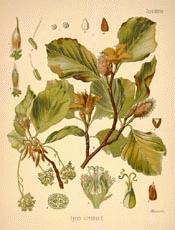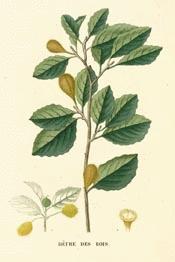
Botanical.com Home Page

|
European beech
(Fagus sylvatica)
Click on graphic for larger image
|
Beech
Botanical: Fagus sylvatica
Family: N.O. Corylaceae
---Synonyms---Buche. Buke. Boke. Bog. Bok. Buk. Hetre. Faggio. Faya. Haya. Fagos.
---Part Used---The oil of the nuts.
---Habitat---Europe, including Britain. (Indigenous only in England.) Armenia, Palestine, Asia Minor Tanan.

|
European beech
Fagus sylvatica
Click on graphic for larger image
|
---History---The common name of the Beech tree, found in varying forms throughout the Teutonic dialects, means, with difference of gender, either 'a book' or 'a beech,' the Runic tablets, or early books, having been made of this wood. Fagus is from a Greek word meaning 'to eat,' referring to the edible character of the Beechmast.
The Beech is one of the largest British trees, especially on chalky and sandy soil. In England it may grow to 140 feet in height, or spread to 130 feet in diameter, with a trunk 21 feet in girth. As the wood is brittle and short-grained, it is not well suited for purposes where strength and durability are required. One of the principal objections to it is that it is liable to be perforated by a small beetle. Its chief uses are for panels for carriages, carpenter's planes, stonemason's mallets wooden bowls, granary shovels, boot-lasts, sabots, and for chair-making, small articles in turnery, also for making charcoal for colour manufacturers, and gunpowder. On the Continent Beech is used for parquet flooring, wood pavement and bentwood furniture, and very extensively as fuel for domestic heating, as its heating power surpasses that of most other timber.
Owing to the capacity of its root system for assisting in the circulation of air throughout the soil, and by the amount of potash in the leaves, Beech trees conserve the productive capacity of the soil better than any other kind of tree, and improve the growth of other trees when planted with them.
Fences of young Beech trees may be employed with advantage in flower gardens, as their leaves generally remain on the branches during the winter and screen the young plants .
The nuts of Beech, called 'mast,' are chiefly used in England as food for park deer. In other countries they are valued for feeding farm animals: in France for feeding swine and fattening domestic poultry, especially turkeys, and pigs which are turned into Beech woods to utilize the fallen mast. Beech mast has even been used as human food in time of distress or famine. Horses, however, should not be fed on it.
Well-ripened mast yields from 17 to 20 per cent. of a non-drying oil - similar to hazel and Cotton-seed oils - and is used in European countries for cooking, as well as for burning, and in Silesia as a substitute for butter. The cake left when the oil has been pressed out may be used as a cattle food.
During the War an attempt was made in Germany to use Beech leaves as a substitute for tobacco, and a mixture was served to the army, but proved a failure.
[Top]
---Constituents---The wood ash of the Beech affords a large proportion of potash. The oil of the nuts occupies a position in the fixed oils between the vegetable non-drying and the true drying oils. Like the Cotton-seed oils, it forms more or less elaidin on treatment with nitrous acid or mercuric nitrate, but does not become wholly solidified. Beech tar is completely soluble in 95 per cent. acetic acid. Turpentine oil, chloroform and absolute ether do not entirely dissolve it. The petroleum ether is not coloured by copper acetate solution. Choline is present in the seeds.
---Medicinal Uses---The tar is stimulating and antiseptic, used internally as a stimulating expectorant in chronic bronchitis, or externally as an application in various skin diseases.
The oil is used in the same ways as the other fixed oils of its class.
---Other Species---BEECH DROPS (OROBANCHE VIRGINIANA,EPIFAGUS VIRGINIANA, BROOM RAPE, CANCER ROOT), a parasite on Beech tree roots, has a bitter, nauseous, astringent taste, diminished by drying. It is given internally in bowel affections, and is reputed to cure cancer, though this is doubtful As a local application to wounds or ulcers it will arrest gangrene. It appears to act upon the capillary system like the tincture of muriate of iron.
ALBANY BEECH DROPS (Pterospora Andromeda) is a rare plant of North America valuable as a sedative diaphoretic in typhus, pleurisy and erysipelas
COPPER-BEECH (F. sylvatica var. purpurea). The leaves of this species may be used like those of the Red-leaved Hazel for the extraction of anthocyan pigment.
[Top]
Common Name Index
A MODERN HERBAL Home Page
Bear in mind "A Modern Herbal" was written with the conventional wisdom of the early 1900's. This should be taken into account as some of the information may now be considered inaccurate, or not in accordance with modern medicine.
© Copyright Protected 1995-2025 Botanical.com
|